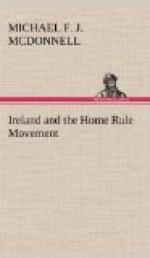We must now turn to the introduction of land purchase. In 1847 Lord John Russell, in a project which was subsequently dropped, advocated, as did J.S. Mill in later years, the solution of the land question by the establishment of a peasant proprietary. The nidus, however, out of which this policy germinated was the right of pre-emption which John Bright secured for the tenants of ecclesiastical land under the Church Act of 1869. A further step in the same direction was taken in the Land Act of 1870—not more than two-thirds of the purchase-money being advanced to the tenant under its provisions. Under the Church Act 6,000, and under the Act of 1870 1,000, tenants purchased their farms.
In 1878 Parnell urged the establishment of peasant proprietorship, and under the Act of 1881 three-quarters of the purchase-money was to be advanced on such terms as to be repayable by instalments of five per cent, per annum for thirty-five years, but only 1,000 tenants took advantage of the facilities thereby offered.
Four years later was passed the Ashbourne Act, so called from the Irish Lord Chancellor responsible for its introduction, and in it we have the first Act—purely for land purchase—which has been applied to Ireland. By it the Treasury found the whole of the purchase-money up to a total of five millions sterling out of the Irish Church Surplus Fund, and forty-nine years were allowed for repayment of the purchase-money to the State at 4 per cent., of which L2 15s. was interest on the advance and L1 5s. went to a sinking fund for the liquidation of the loan.
Only 2,000 tenants took advantage of the terms of this Act, but it is nevertheless of importance as marking the point at which the principle of peasant proprietorship was recognised as the solution by both English parties. In this way was realised, not much more than twenty years ago, the importance of that change of ownership which, in Arthur Young’s well-known phrase, turns sand into gold, and which has progressed ever since. A shrewd French observer—Gustave de Beaumont—saw in 1837 that this was the way out of the impasse of the Irish land system, and half a century ago a great opportunity presented itself at the time of the Encumbered Estates Act of establishing a peasant proprietary, when more than two million acres—one-sixth of the whole soil of Ireland—were sold in ten years, and were bought in lots of 200 to 250 acres by some 8,000 to 10,000 land-jobbers.
The Land Bill which Mr. Gladstone introduced as a pendant to the Home Rule Bill of 1886 offered to every Irish landlord the option of selling his estate to his tenants, who would thereby become occupying owners at once, paying an interest of 4 per cent. for forty-nine years on the price, which would be twenty years’ purchase of the judicial rents, paid by the State issue of fifty million pounds of Consols with the revenues of Ireland as security. After the Unionist victory of 1886 Mr. Parnell brought in a Bill which also was destined never to receive the Royal Assent, but which again is of importance in view of subsequent legislation.




